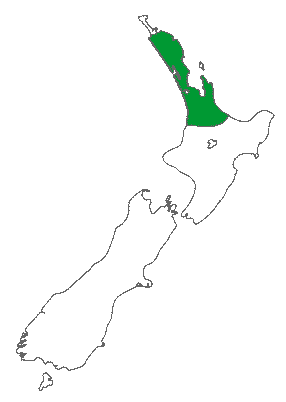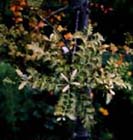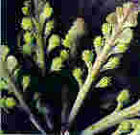
Mature tree, Waipoua Forest, New Zealand [Trevor Hinchliffe].

Distribution map (Metcalf 2002).

Foliage of a tree in Waipoua Forest, New Zealand [Trevor Hinchliffe].

Foliage (nameless page at wisc.edu, accessed 2001.03.15, now defunct).

Detail photograph [J. E. Braggins].

Bark of a tree in Waipoua Forest, New Zealand [Trevor Hinchliffe].

Phyllocladus toatoa
Molloy 1996
Common names
Toatoa (Maori), blue celery pine.
Taxonomic notes
Syn: Phyllocladus glaucus Kirk 1869 non Carriere 1855 (Farjon 1998).
Description
"Dioecious or monoecious tree up to 15 m, trunk up to 6 dm diameter. Phylloclades alternately pinnately arranged on whorled rachides up to 4 dm long. Leaves of juveniles up to 1.5 cm long, linear, obtuse to subacute, deciduous; of adults much smaller. Phylloclades 10-12 per rhachis, rhomboid, unequally cuneate at base, to broadly ovate or oblong, glaucous below when young, 4-6 × 2-4 cm, shallowly to deeply lobed, margins finely crenately lobulate; leaf-denticles small, subulate, curved. Male strobili in clusters of 10-20, terminal, pedicels equalling staminal portion, 1-2.5 cm long; apiculus broadly oblong. Ovules in globose heads, 4-7 together, seated towards base of rhachis on pedicels ca. 5 mm long. Mature heads up to 15 mm long; carpidia thick, upper margin truncate; seeds nutlike, exserted beyond white cupule, ca. 3 mm long" (Allan 1961).
Distribution and Ecology
New Zealand: NW N Is, lowland and montane forest from lat. 35° to 39° S at 850-1000 m elevation (Allan 1961, Silba 1986). Based on data from 21 collection localities, its climate preferences include a mean annual temperature of 13.3°C, with an average minimum in the coldest month of 4.5°C, and a mean annual precipitation of 2114 mm (Biffin et al. 2011, Table S5). The species is locally common on relatively infertile soils in lowland and montane forests from the central North Island northwards. It is well protected and not considered to be a threatened species (Molloy 1996).
Remarkable Specimens
No particularly large or tall trees are recorded. One tree-ring chronology, presumably based on living tree material, covers 441 years (International Tree-Ring Data Bank, chronology NEWZ009, limiting dates 1535-1976). It was collected and reported by Dunwiddie (1979), in an exploratory dendrochronological investigation.
Ethnobotany
See Conifers of New Zealand for a review of the historic role of forests in native and European cultures of New Zealand.
The species has research value. Four tree-ring chronologies were collected in the early 1970s by the Americans Valmore C. LaMarche Jr. and Peter Dunwiddie in what were evidently the first explorations of the dendrochronological characteristics of the species (Dunwiddie 1979, Ogden and Dunwiddie 1982). Shortly thereafter, the Australians and New Zealanders began work in the area, assembling chronologies for a variety of native gymnosperms and successfully applying them to a variety of problems in work summarized by D.A. Norton, John Ogden and J.G. Palmer (Norton & Palmer 1992, Palmer & Ogden 1992). Recently, the species has been employed in a reconstruction of New Zealand climate indices since A.D. 1731 (Salinger et al. 1994).
Observations
Some fine trees, along with seedlings and saplings, can be seen along the Toatoa Track at Waipoua Forest. This loop track identifies many of the native trees, and also affords the opportunity to see the elusive Halocarpus kirkii. Some fine trees can also be seen in the canyon at Whangarei Falls, just outside of Whangarei.
Remarks
The epithet toatoa is the common Maori name for this tree.
Citations
Allan, H. H. 1961. Flora of New Zealand. Volume I, Indigenous Tracheophyta. Wellington: R.E. Owen Government Printer.
Molloy, B. P. J. 1996. A new species name in Phyllocladus (Phyllocladaceae) from New Zealand. New Zealand Journal of Botany 34: 287-297.
See also
The New Zealand Plant Conservation Network, accessed 2010.11.22.
Gymnosperms of New Zealand.






